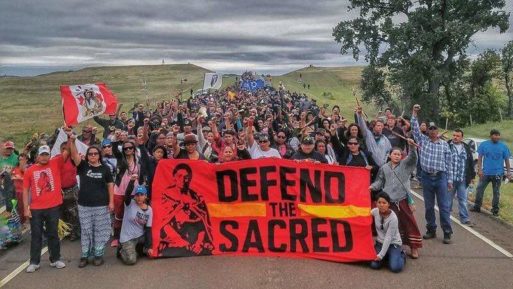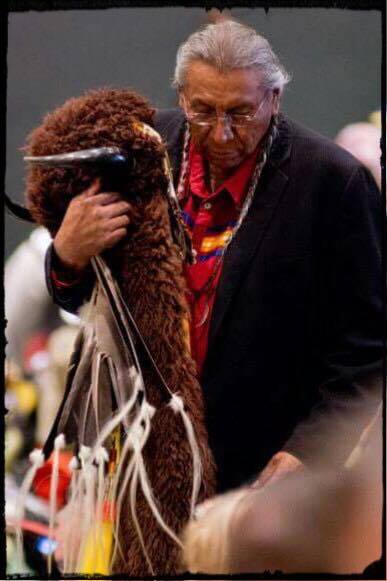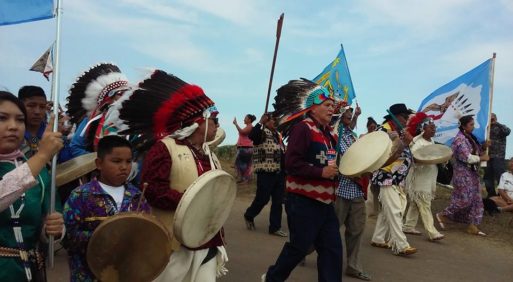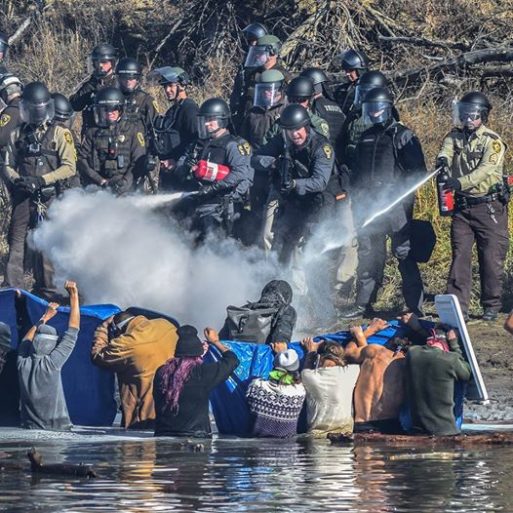
Water Protectors at Standing Rock
(Credit: huffingtonpost.com)
The standoff on and near the Standing Rock Sioux reservation between indigenous-led resistance to the Dakota Access Pipeline project and security and police forces is currently making global headlines. At issue are the land rights of indigenous people, the human right to clean water and the need for sustainable energy solutions, among other matters. The land and water protectors at the prayer camps are also defending ancient and modern burial sites that the DAPL project is currently excavating.

Chief Arvol Looking Horse of the Lakota, Dakota, and Nakota Nations, and keeper of the Sacred White Buffalo Calf Pipe
(Credit: indiancountrytodaymedianetwork.com)
Chief Arvol Looking Horse of the Lakota, Dakota and Nakota Nations (of which Standing Rock is a part) has responded to the international attention with this statement:
“Look around you. Our Mother Earth is very ill from these violations, and we are on the brink of destroying the possibility of a healthy and nurturing survival for generations to come, our children’s children.”

Indigenous water protectors leading a peaceful demonstration at Standing Rock
(Credit: 3.bp.blogspot.com)
Dakota Access LLP bought privately owned land that the Lakota/Dakota/Nakota Nation believes is a part of their traditional territory, including the contested Cannonball Ranch site. The contested area includes land rich with ancient artifacts and human remains. Independent media reports that after the destruction of tribal burial grounds there on September 3, 2016, “more than 1,200 archaeologists and museums sent a letter to President Barack Obama, the Department of Justice, the Department of the Interior and the U.S. Army Corps of Engineers urging a full Environmental Impact Statement… as well as a survey of cultural resources along the pipeline’s route.” Those responsible have failed to complete the requested surveys, and construction of the pipeline continues as of this date.

Riot Police assault peaceful demonstrators with pepper spray and tear gas on Nov. 2
(Credit: bsnorrell.blogspot.ca)
On November 2, riot police injured over 100 peaceful and unarmed water protectors while they were holding a water ceremony. Iconic storyteller LaDonna Bravebull Allard says, “[Riot police] parked their armored cars on the graves of Matilda Gaplin, Eagle That Looks At Woman, and… her daughters Louisa DeGrey Van Solen and Alma Parkins who once owned the Cannon Ball Ranch. Next to her is her husband Charles Parkins, and 11 babies. These are famous people for us here in Indian country. Matilda was the only woman to sign the Fort Laramie Treaty of 1868. Louisa was the first school teacher on Standing Rock. I am deeply hurt to see the desecration of their graves.”
On November 6, water protectors in three different locations held peaceful demonstrations against the desecration of ancestral burial sites, including an area near the Cantapeta Creek dubbed Turtle Island. (This term commonly refers to the entire landmass of North America). While protectors were crossing the Cantapeta to defend the bones of their ancestors, a smaller group of several dozen individuals gathered in the nearby city of Bismarck at its old burial site, Fairview Cemetery. They invited the “Black Snake Killaz” (people working for and supporting the Dakota Access Pipeline) there to join them in prayer. Protectors brought red shovels with them as a symbolic gesture.
In the video above, mainstream news highlights the personal impact that the Fairview Cemetery demonstration had on one person with relations buried there. However, they fail to note that the “pain” she experienced is the catalyst required to foster understanding across cultures and nations. We all value and respect our beloved dead, and our relationship with our ancestors links us to the land that supports all our lives. The video is also heavily slanted against indigenous protectors. It cites an archaeologist paid by Dakota Access LLP, who provides inaccurate information about DAPL protocols. Dakota Access LLP has, in fact, failed to consult the Standing Rock Sioux and continues to disrupt burial sites. Construction of the DAPL forges ahead, despite warnings from archaeologists, environmentalists and human rights advocates.

 Standing Rock Land and Water Protectors Defend Burial Grounds From Desecration by Big Oil
Standing Rock Land and Water Protectors Defend Burial Grounds From Desecration by Big Oil


 “As Tears Go By” by Marianne Faithfull
“As Tears Go By” by Marianne Faithfull

 Funeral Favors Offer Visitors a Tangible Memento
Funeral Favors Offer Visitors a Tangible Memento















